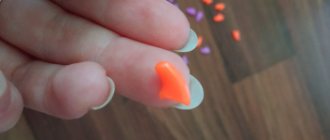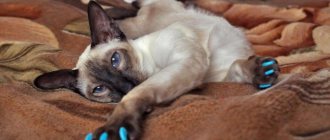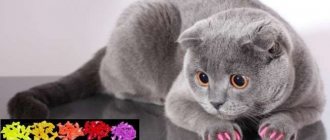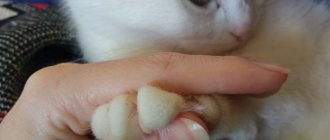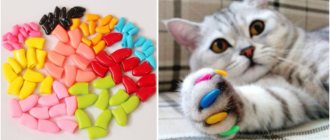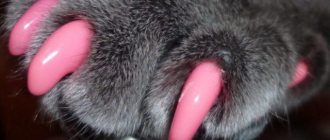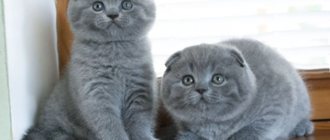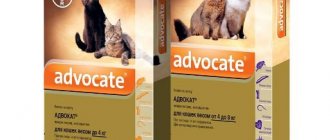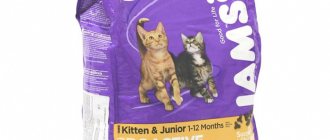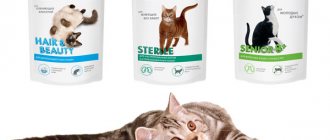What kind of device are anti-scratchers for cats?
Owners owe the appearance of silicone caps on the pet supply market to the American veterinarian Toby Wexler. He was against the inhumane method of declawing and figured out how to avoid it. This happened in 2003.
Appearance
The tips are made of silicone, which does not contain toxic elements. They are created in such a way that they fully correspond to the anatomical shape, repeating all the curves. The tips themselves do not injure the paw and do not even prevent the retraction of the claw. Now there is a wide range on sale:
- different colors (red, green, yellow, purple, black);
- transparent;
- fluorescent (glow in the dark);
- with sparkles.
The caps are attached with medical glue, which is absolutely safe for any living beings. If your pet chews and tries to swallow its accessory, then no harm will come from it. Anti-scratch pads can be used not only for cats, but also for small breed dogs.
Purpose
Silicone accessories, which were invented in the USA, are widely distributed throughout the world. For now, this is the only humane way to save furry owners from troubles with damaged wallpaper, furniture and curtains. But combating damage to things is not the only purpose of anti-scratch products for cats. They are successfully used in the following situations:
- Health problems for the owner or his family members. Diseases include problems with blood clotting or allergies of various types.
- Presence of small children in the apartment. Kids can provoke even the most phlegmatic fluffy into aggression. Silicone kits will help protect your child from injury.
- Aggressive cats. Some animals, due to their breed or character traits, can rush at people at the slightest irritation. Also, pets with illnesses may demonstrate hostility towards humans before recovery.
You should not purchase tips just for their attractive appearance. If the pet is not mischievous or does not demonstrate inappropriate behavior, then the use of such devices is not relevant.
average price
Cat claw caps are sold in sets of 20 or 40 pieces. The kit comes with instructions and medical glue. The average cost of a set is 250-350 rubles. (for 20 pieces).
If the price is an order of magnitude lower, then this is a reason to doubt the quality of the devices. Usually, kits with low-quality glue are cheaper, which can become unsafe, causing allergies or poisoning.
What are silicone claw pads (anti-scratch)
Anti-scratch pads are cap-shaped covers for animal claws. The caps are made of soft, flexible silicone. The linings are also called “soft claws”. They are placed over cats' clipped claws to protect them from scratching.
anti-scratch is a device for protection against scratching
Anti-scratch pads were invented by veterinarian Toby Wexler (USA). This discovery became an alternative to onychectomy (declaw removal), as painful removal was considered the most inhumane way to protect against scratching. In civilized countries, onychectomy is prohibited, so anti-scratch treatments quickly became popular throughout the world. They come in different sizes, so they are suitable for cats aged four months and older. In addition, caps are now sold in different colors. However, anti-scratch pads are not just a fashionable device; sometimes purchasing such pads is vital. It is recommended to purchase claw pads in the following cases:
- if the animal is aggressive and rushes at guests;
- if the cat is overly playful and therefore violently attacks family members;
- if the cat is jealous and cannot come to terms with the appearance of another pet in the house (trying to “revenge” it);
- if there are small children in the house;
- if your pet has health problems (for example, with atopic dermatitis, the cat itches, scratching the skin until it bleeds).
The benefits and harms of caps
Any pet product has both positive and negative characteristics. This is explained by the peculiarity of mustaches, their individual needs and character, as well as the preferences of the owner.
Undeniable advantages
The positive aspects of wearing silicone pads are obvious, and there are quite a lot of them. The main thing is that the mustache normally perceives their presence on its paws and does not try to chew them off. Advantages of devices:
- keeping furniture, walls and curtains in good condition;
- lack of possibility of causing injury to a person;
- Can be used at any age.
When worn correctly, these cute little silicone things won't cause any discomfort to your furry friend. Over time, he will stop paying attention to them, and then the owner will be completely calm about the safety of his home.
Possible disadvantages
Of course, there are also negative sides to using tips. However, they can be avoided with the correct selection of accessories. It is important to consider not only the attractive appearance of the product, but also how comfortable the mustache is.
The disadvantages that may arise include:
- fragility (maximum month, and average service life - 2 weeks);
- different period of adaptation - the cat may never get used to the innovation;
- they squeak unpleasantly or knock on the floor when walking or burying the tray;
- possible deformation of the nail plates, their separation.
Fluffy purrs, like people, have different mentalities. Therefore, the period of adaptation for some pets may take a couple of weeks, while others will forget about the caps in just a couple of hours.
Age restrictions
Manufacturers of products for mustachioed consumers claim that there are no restrictions on the use of stickers. However, veterinarians do not agree with this. In their opinion, it is not advisable to use kits for kittens up to six months of age. Their nail plates themselves are very soft and easily wear off when walking or playing.
Nail caps are not useful for older cats. Old people usually lose interest in curtains and pieces of furniture, so there is no point in protecting them.
The same can be said about free-ranging animals. An individual who spends a lot of time outdoors will not be able to climb a tree or protect itself from enemies if cute accessories are put on it.
The benefits and harms of anti-scratch products for cats
anti-scratch products can be harmful to your pet's health
The benefits of anti-scratch pads are obvious. A cat wearing such a “manicure” will not be able to harm either things or children. Moreover, the animal will not be able to harm itself.
Every cat breeder has seen how cats itch. Some animals do this with particular frenzy. In this case, the pet can scratch its skin until it bleeds (or even tear its skin). Because of this, wounds are formed, which itch even more as they heal. They can also become infected.
In addition, some “advanced” cat owners try to purchase all kinds of devices for their pets. Instead of gray (yellowish, sometimes ugly) claws, the cat's paws will have beautiful "soft claws." But in addition to benefits, anti-scratch products can also cause harm. The pad may grow into the pad of the paw. But claws can grow in without a cap, so this is only indirect harm. You need to examine your pet's paw more often. Typically, ingrowths occur when they are not applied correctly. According to the rules, the cap should not fit to the claw all the way to the base, but with an indentation of several millimeters. You should also not put caps on untrimmed claws.
In addition, the cat can get injured (and even pull out a claw) if the pad gets stuck in something. To prevent this from happening, you need to monitor what the animal comes into contact with. For example, the cap can get stuck in grilles or cracks, or get caught in blinds or long carpet fibers. After all, a cat walking outside can get stuck in a tree or get caught on a nail. Control is especially important at first, until the cat adapts to the anti-scratch treatment.
Choice among variety
The right product successfully replaces the removal or trimming of the nail plate. The main thing is to guess the size and buy harmless glue.
Size is the most important thing
When purchasing, you need to take into account the weight and thickness of the nail plate of the homemade mustache. A sizing guide can be found on any package with caps. Conventionally, there are 4 types:
- For small animals and kittens (up to 1.5 kg) – the smallest size is XS.
- For fluffies weighing from 1.5 to 4 kg, S is suitable.
- For individuals with a body weight of 4-6 kg, size M is intended.
- For large breeds or dogs weighing more than 6 kg, use size L.
High-quality products are made from thin and pliable silicone, which does not wear out for a long time and does not cause discomfort to the cat. Cheap analogues quickly crack, fly off and cause a lot of inconvenience. Therefore, quality and size are the determining factors when purchasing protective devices.
What about glue?
Not only the material from which the pet product is made is important, but also the glue included in the set. This substance should do more than just keep the cap on the animal's paw. The comfort of wearing devices depends on the quality of the glue. If it contains harmful components or is expired, then irritation and inflammation may occur from its use.
When purchasing a kit, you need to make sure that the glue included in the kit has a medical purpose and a good shelf life. If the product was purchased a long time ago, then the spoiled composition can be replaced with the appropriate one from the pharmacy.
Anti-scratch claw caps for cats (40 pcs)
1. Try on the cap
Take the cat's paw in your hand. Lightly press the pad of the foot with your index finger, holding the top of the claw with your thumb, so as to release the claw. Place the cap on the claw. The cap should completely cover the surface of the claw.
2. Trim caps or claws as necessary
If the Anti-Scratch caps are large in size, cut them from the side of the claw hole. If the nails are larger than the caps, trim the nails. Attention! Trim only the narrowest tip of the claw (no more than 1-2 mm) so as not to touch the blood vessels that are in the claw. In addition, a heavily trimmed claw reduces the bonding area, which reduces the life of the cap.
3. Apply glue to the inner surface of the cap
The glue should fill no more than 1/3 of the volume of the cap. Attention! The glue can stain furniture and clothes, so prepare your work area in advance. We recommend filling 10 caps with glue at once.
4. Put caps on your claws
To do this, press on the pad of the paw so as to release the claw out, as was done in step 1 of the instructions. Place the anti-scratch pads onto your claws using a sliding motion. Then lightly, for 5-10 seconds, press each cap onto the claw from the sides to fix the glue. Hold the cat in your arms for another 5 minutes so that the caps have time to stick.
Additional notes:
- If the cat is not accustomed to handling claws, then the first time she may resist. To overcome resistance, give your cat a massage by gently massaging its paws with your fingers. It is advisable to repeat this procedure several times, for 5 minutes once a day.
- Sometimes cats that are not accustomed to soft caps may try to chew them off. This is normal behavior, so replace caps that fall off with new ones. After a few days the animal will stop gnawing on them. If the instructions are followed correctly, Anti-ScratchTM can stay on the claws for up to two months, since the claws of a healthy cat change every 1-2 months.
- The caps will last longer if, before gluing them, you wipe the claws with a cotton swab and a disinfectant that does not contain acetone to remove dirt from the surface.
- You can also increase the service life of the caps if you use a nail file to make the surface of the claw a little rougher for better adhesion.
- It is advisable to use a special nail trimmer to trim caps and claws, although regular scissors will also work.
- Glue-stained fingers can be cleaned by using nail polish remover or by rubbing one hand against the other while holding them in warm water.
- Usually, soft caps are only placed on the cat's front paws, since the animals mainly scratch only with them. For greater protection against scratching, you can put caps on the hind legs.
How to use
The first attempt to use overlays is not always successful. But this does not mean that you should give up silicone caps - you should be persistent and not give up.
Preparing animal claws
To carry out the first stickers, it is important to enlist the support of one of the family members. This will make the first attempt more successful and less traumatic.
First, you need to carefully examine the claws of your furry friend. They often differ in length, so the tip is tried on each finger separately.
A little pressure is applied to the paw pad so that the cat opens it, after which 2-3 mm of the claw is cut off with special nippers. The cut can be sharpened with a soft file, then there will be no sharp edges left.
Next, try on the overlay. It is important to make sure that it is pressed tightly and that there is 2 mm left to the base of the claw. Tips that are too long can be shortened slightly to make them easier to wear. To do this, the edges are trimmed with nail scissors.
In long-haired cats, long fur between the toes often gets in the way. In order not to stain it with glue, it is recommended to cut off any protruding hairs immediately before the procedure.
Algorithm for gluing procedure
Detailed instructions on how to glue anti-scratch pads to cats' claws are included with each kit. It is the same for protective sets of any size and color. The gluing algorithm looks like this:
- Glue is poured inside the lining, which should fill no more than half of it.
- By pressing on the pad with your fingers, you need to release the claw so that it appears at its full length.
- Step back 2 mm from the base and put on the tip, avoiding any glue getting on the fur.
- Hold for up to 10 seconds for better adhesion.
- Do not let go of your pet for 5-7 minutes so that the glue dries completely and sets.
During the procedure, the cat should experience a minimum of discomfort. Otherwise, re-sticking will not arouse positive expectations in him, and then it will be difficult to force him to this procedure.
Precautionary measures
It is more convenient and safer for the owner to use protective nails only on the front paws of the pet. This is also rational - it is with them that fluffies cause harm to surrounding objects.
The hind legs can be left alone. As a last resort, they can be filed or lightly trimmed.
During the procedure, the mustachioed friend must be securely fixed so that he cannot harm the person, run away during the procedure, or get dirty in the glue. It is better to stick the caps together: one holds, the other performs manipulations. You can’t put too much pressure on your pet, much less cause him pain.
After complete drying, watch your pet so that he does not actively chew the silicone. Distract your furry one with a treat or game.
Do not let the glue come into contact with your own hands or the cat's fur. The glue will be difficult to wash off, so it is better to use gloves or an old blanket in which you can wrap a restless animal.
Rules for using anti-scratch pads
Before you start working with anti-scratch products, you need to carefully study the instructions
The package can include up to 40 pads, glue and instructions. Before starting work, you should carefully study the operating instructions. If you stick the caps only on the front legs, the package will be enough for 4 times. The pads stay on the claws for up to 8 weeks. If the cat does not take them off earlier, and you put them on strictly according to the instructions, then the packaging will last for several months (up to six months) . If you make a mistake with the size, the caps can be changed at the seller or trimmed. At the time of fitting it will become clear whether there is such a need.
When not to cap cats' claws
Anti-scratch guards are intended for domestic cats. That is, for those animals that do not end up on the street. Firstly, the owner cannot always keep track of the cat if it goes out. And there are many dangers on the street (for example, claw injury). Secondly, the animal must be able to climb to some height (if necessary).
Anti-scratch guards should also not be placed on the claws of pets prone to allergies (the cat may not tolerate glue). The original packaging comes with good quality glue, so the risk of allergies is low. But no one can guarantee the quality of the glue that comes with cheap fakes.
It is not advisable to stick caps on the claws of a sick cat
If your pet is sick, it is better not to irritate him with innovations. A weakened animal may not resist, but due to an unexpected “manicure” the cat may become stressed. This may make the condition worse.
How to glue cat claw caps
Before gluing the pads, you need to organize a fitting (without glue) on already trimmed nails. There is no need to trim the nails completely. It is enough to cut off the sharp corner of the claw and also treat it with a nail file on all sides. After this, the claws are degreased, for example, with alcohol (you can use acetone, but the cat may not like the pungent smell). This is necessary for better adhesion to the glue. The cap should not slip off, and its edges should be at a distance of 3–5 millimeters from the base of the claw. If this indentation is not a balloon, then the overlay can be shortened using scissors. After trying on all the caps, you can begin gluing. You need to work with glue very carefully. If there is too much of it, a drop of glue will fall on the cat's fingers, and it will hurt the cat when it moves. You can follow the following plan:
- Calm the cat (you can pet it or give it a treat) so that it is not afraid.
- Place a small amount of glue inside the cap.
- Take the cap in your right hand, and lightly press on the paw with your left so that the animal releases its claws.
- Place the cap on the desired claw (without releasing your left hand).
- Make sure that the glue does not get on the skin near the claw.
- Wait a while (5 minutes) until the glue dries.
If there is still a lot of glue, you need to wipe off the excess with a napkin. This must be done quickly so that the glue does not have time to dry. After gluing all the caps, the cat will try to rip them off, so you need to distract the cat (with food or a toy) for some time after the procedure.
How often do you need to change the pads?
You should not remove the caps yourself, especially if this is not associated with a threat to health and life. The additional manipulation of removing the tips will cause further stress for the cat. Objective factors that require ridding the animal of protective kits are:
- allergic reaction;
- improper gluing;
- prolonged nervousness.
It is important to understand that this is not only decoration. They cannot be changed when the owner is tired of the appearance. A person’s whim is not a reason to subject an animal to an unnecessary procedure.
How often should you change cat claw attachments?
It is possible that from time to time the cat will remove the anti-scratch protection itself.
If your four-legged friend sometimes tears off (loses) the pads, they can be re-glued. You cannot use the old cap; you will need to glue a new cover each time. Moreover, you don’t have to wait until all the anti-scratch pads fall off; you can add them one at a time.
Some who have never tried it before buy several sets of anti-scratch products in different colors. For example, in bags of 10 or 20 pieces. Using the entire set at one time, for “correction” you will have to open another bag. The next time you completely replace all the pads, one cap may not be enough. Therefore, it is more convenient to buy anti-scratch pads with a large number of pads of the same color, for example, 40 or 60 pieces. Or buy several packages of different colors and mix. Such methods are suitable for those people who already have an adult cat (the size of the claw will not change).
Of course, anti-scratch pads do not stick forever. The natural claw must sometimes be released, but tearing off a tightly fitting pad is painful for the animal. Therefore, you can wait until your pet's claw is updated. As the claw tissue is renewed, old cells will die off. Thus, the cap will easily come off along with the dead layer of the claw. This can happen about a month after gluing. In younger cats, this period may be shorter (about 3 weeks), but this is rare. A properly glued cap can last up to 8 weeks.
Duration of use
Protective accessories fall off the paws on their own as the nail plate grows. Therefore, their service life is related to the health, lifestyle and behavior of the cat. On average, the period of wearing the kit lasts from 2 to 4 weeks, and sometimes reaches 2 months.
In some cases they may be lost. The eared friend leaves them in the long pile of the carpet or chews them off.
Anti-scratch vs surgery, scratching post and trimming
In addition to protective kits, the pet store also offers other means designed to save your home from destruction: sprays, special pheromones, which, alas, do not always work.
Another effective, but completely unacceptable for any pet, method is onychectomy - surgical removal of the claw and part of the finger. This is a very dangerous procedure that leads to dire consequences. The cat becomes disabled and cannot lead a full life and take care of itself. Many animals lose their mental health after onychectomy, which is why the operation is prohibited by law in some countries.
A scratching post becomes a solution if the cat has been trained to use it. In other cases, it simply does not work - or the pet uses both the scratching post and the owner’s favorite chair.
Trimming nails is only partially effective. Claws grow quickly, and they sharpen even faster. They have to be trimmed with a nail file all the time, and this takes a long time. Not every cat will sit for 10 minutes and endure the unpleasant procedure.
Therefore, protective kits become the best alternative. They can be used regularly, or for a short period of time - for example, during a trip, a long stay with relatives with small children, or a visit to the veterinarian.
What do veterinarians say?
There are no clear reviews among veterinarians about anti-scratch products for cats. But most doctors tend to recommend them for their mustachioed patients.
Common Myths
Despite the fact that manufacturers insist that silicone claws are completely safe for the health of your mustachioed friend, there are quite a lot of myths about their use. Here are the most common reasons why owners do not want to purchase the “soft paws” accessory:
- The claws itch underneath. This is incorrect because there are no nerve endings on the nail plate.
- They interfere with retracting the claws. In fact, everything is attached to the tip, which sticks out of the pad.
- The animal's gait changes greatly. This is true, but not for all cats and for a very short period of time.
- The material and glue are toxic. Manufacturers and veterinarians say this is not true. Even ingestion cannot harm your pet.
To make use as comfortable as possible, it is necessary to follow the order of gluing them. In addition, when choosing silicone kits at a pet store, it is important to carefully read their composition and instructions.
